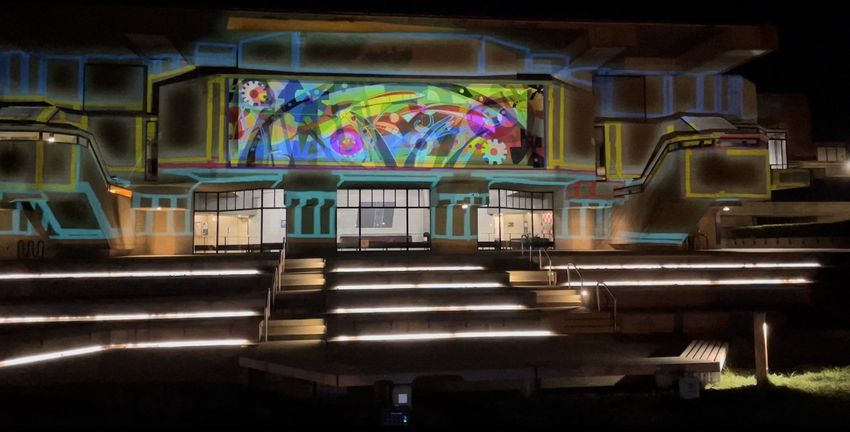UMass Dartmouth and UMass Amherst host symposium on brutalist architecture
Collaborative two-day event celebrates the history, preservation, and future of brutalist architecture.
Members of the UMass community gathered in Dartmouth Friday, October 22, and in Amherst Saturday October 23, to celebrate the past, present, and future of Brutalist architecture on the UMass Dartmouth and UMass Amherst campuses.
The sold out symposium — part of the UMassBrut collaboration — provided a unique platform that brought together a team of distinguished scholars, industry professionals, artists, and passionate citizens with an interest in the preservation of mid to late twentieth-century architecture. UMass Dartmouth Chancellor Mark Fuller kicked off the event with a welcome reception.
“We’re delighted to host this event and to celebrate the stunning mid-century architectural heritage that makes our campus so unique,” said Chancellor Fuller. “For me personally, the first time I stepped foot on this campus, I was immediately drawn to the beauty of its brutalist design, and I’m committed to preserving that beauty on this campus.”
Friday’s events began in the Stoico/FIRSTFED Grand Reading room of the Claire T. Carney library, with lectures from scholars of Brown University, Roger Williams University, Rutgers University, UMass Amherst, UMass Dartmouth, and the University of South Carolina. Question and answer sessions followed each presentation.
Following a break for lunch, Keynote speaker Chandler McCoy, AIA, LEED AP, a Senior Project Specialist of the Getty Conservation Institute, discussed the unique challenges and importance of preserving modern built heritage, clarifying the role that modern university campuses play as part of this heritage. McCoy introduced the Conserving Modern Architecture Initiative’s (CMAI’s) latest case study book on managing energy and thermal comfort in modern buildings and discussed lessons learned with descriptions of several of the case studies, all of which demonstrate how it is possible to balance historic preservation and energy upgrading.
“Concrete is one of the most important materials of the modern movement,” McCoy said. “Not that I have to tell anyone here at UMass about that.”

Following McCoy’s keynote address, over 100 members in attendance were guided by Art History Professor Anna Dempsey on a tour of UMass Dartmouth’s main quad and Liberal Arts building to explore the creative vision of Paul Rudolph, the brutalist architect who designed the foundation of UMass Dartmouth’s campus in 1963.
After the tour, attendees returned to the Stoico/FIRSTFED Grand Reading room of the Claire T. Carney library for additional lectures given by industry professionals from designLAB Architects, Roll Barresi & Associates, Leslie Saul & Associates (LS&A), Sladen Feinstein Integrated Lighting, Goody Clancy, Stantec Architecture, and UMass Amherst campus planning. Among the speakers were part of the team that renovated the Claire T. Carney Library in 2013.

“[The renovation to the library] is certainly proof of what we can do with these brutalist structures,” said Rose Mary Botti-Salitsky, Associate Professor/Program Coordinator of Interior Architecture and Design at UMass Dartmouth, and the session chair for Humanizing the Brutalist Interior. “It shows the potential to increase and integrate technology that didn’t exist at the time these structures were built.”
“One of the primary goals of the renovation to the Claire T. Carney Library was to get students into the building,” said Ben Youtz, AIA, Partner, designLAB Architects. “The library was not well-loved by the campus prior to the renovation. We saw a huge opportunity through the renovation to get students to activate and use this building. It’s so gratifying to walk back in here and know the choices we made have succeeded and held up really well.”
Putting the night cap on Friday’s events, Kelvin Dickinson, President of the Paul Rudolph Heritage Foundation, presented: A Discovery of Opposites: Paul Rudolph & the Poetics of Brutalism at UMass Dartmouth inside the college of Visual and Performing Arts’ (CVPA) voluminous atrium. Dickinson discussed Paul Rudolph’s inspirations, philosophies, vocabulary, tendencies, and projects before pausing to allow painting instructor David Burr to present a participatory artwork. Burr invited attendees to experience Rudolph's cavernous and cave-like spaces by following a 3,000-foot rope 'drawing' that winds through the CVPA.

At the conclusion of scheduled events, attendees were encouraged to step into the main quad to see a projection art display shown on the MacLean Campus Center. The series of videos and montage of colorful images celebrated the UMassD campus by highlighting its history, architecture, expansion, and the University's connection to local communities.
The symposium was sponsored by UMass Dartmouth's College of Visual & Performing Arts and Creative Economy Grant from the Office of Research Administration, Ellenzweig, Suffolk Construction, the Association for Preservation Technology International, the Association for Preserving Technology New England, Finegold Alexander Architects, Dimeo Construction Co., Goody Clancy, JCJ Architecture, Stantec and Docomomo US/New England, AIA Western Massachusetts, Boston Society of Architects, BCA Architects PC, designLABarchitects, John Whitsett Architects, and through generous grants from UMass Dartmouth and UMass Amherst departments.
UMassBrut consists of a collaborative advocacy group made up of UMass Dartmouth and UMass Amherst faculty members, staff, librarians, administrators, students, alumni, and interested parties dedicated to celebrating, preserving, and reimagining our mid-century Brutalist public architecture. Organizers include faculty members from a wide variety of disciplines (such as the arts, humanities, architecture, and engineering), librarians, university curators, gallery directors, staff from campus planning, capital projects, environmental safety, and undergraduate and graduate students from both campuses.
"UMassBrut's mission is to raise awareness of the relevance and international significance of our Brutalist architectural heritage. To achieve this goal, we are developing a series of multi-year initiatives combining cross-interdisciplinary events, social media, and public outreach campaigns," said Allison Cywin, Librarian and Director of the Visual and Media Literacy hub. "These activities will promote the importance of these architectural icons and highlight the critical need to preserve them now and for future generations. UMassBrut has raised more than $40,000 in grants, sponsorships, and departments' support, giving us the seed money to pursue future activities."
Future UMassBrut events can be found at their website.